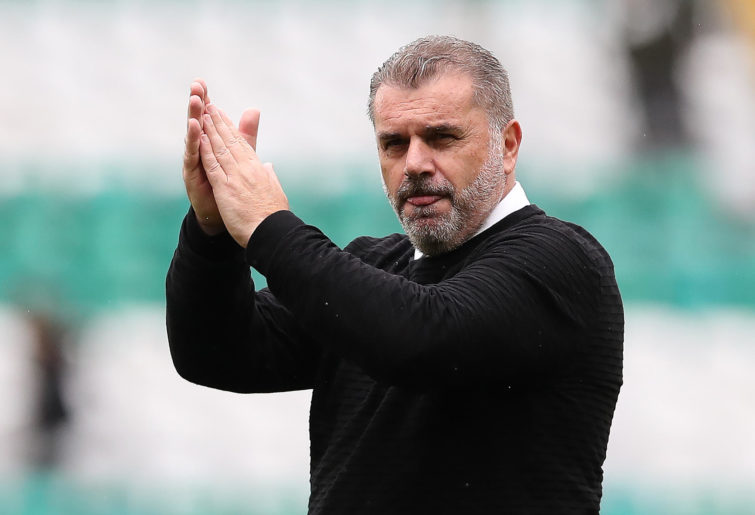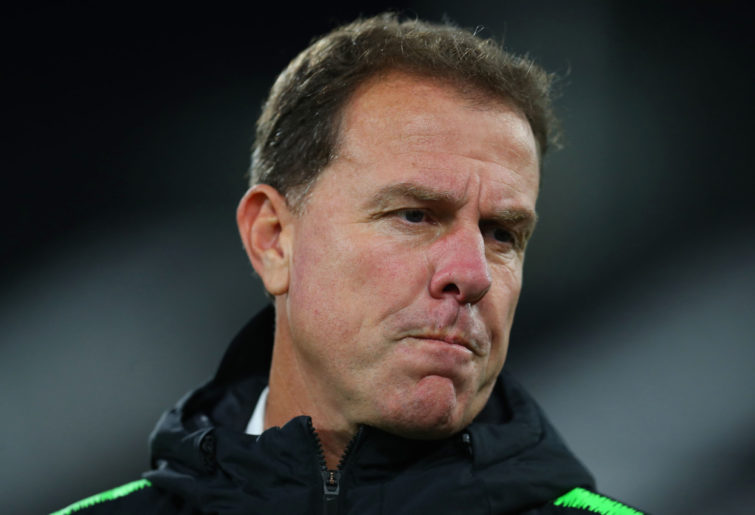Ange Postecoglou’s Celtic beat Livingston 3-1 on Sunday afternoon and Australia’s highest achieving football coach stands within a few solid months of claiming the Scottish Premiership in his first season at the helm.
Prior to a ball being kicked, there was much scepticism around whether the man now lovingly known as ‘Big Ange’ by the Celtic fans was the right person to be overseeing their club’s resurgence.
Some were openly critical, while others were more prepared to see what the 56-year-old had to offer.
His blunt, honest and unique press conferences will become stuff of Celtic legend. He mocked journalists who called the season all done and dusted when Rangers opened a point’s gap at the top of the ladder, then calmly watched his vision come to life in the following months.

(Photo by Ian MacNicol/Getty Images)
Elsewhere, Kevin Muscat’s Yokohama F.Marinos have begun the new J-League season with a bang. Three wins and a draw from their opening five matches have the club nominally top, matched only on points by last season’s champions Kawasaki Frontale.
Despite some disparity in the number of matches played, the two clubs could be destined to fight it out for the championship once again after occupying the top two spots last season.
Muscat is doing brilliantly in Japan, in spite of concerns around his style adapting to the Japanese game.
To this point, he has presented nothing but organised and highly competitive teams on a week-to-week basis and like Postecoglou, he must be drawing attention from third parties keen to improve their coaching stocks elsewhere.
Currently, Postecoglou has a 70 per cent success rate in Scotland and Muscat has a 56 per cent success rate in Japan, both impressive returns.
Alen Stajcic did what many thought unlikely and led the Philippines national women’s team to the knockout phase of the recent Asian Cup tournament, where the Matildas collapsed rather embarrassingly.
Entering the tournament ranked only higher than Indonesia, Stajcic guided his team to two group wins, then they toppled Chinese Taipei on penalties in the quarter-final, before eventually losing to Australia’s conqueror South Korea in the last four.

(Catherine Ivill/Getty Images)
After incredible success at the Central Coast Mariners in 2020-21, Stajcic’s achievements suggest he is one of the best minds in the business, despite Football Australia appearing to think otherwise.
In 2019, Joe Montemurro was a nominee for the FIFA World Women’s Coach of the Year award and rumours continue to circle about the future of Patrick Kisnorbo, with a second title at Melbourne City potentially stamping his credentials as a coach deserving of opportunity elsewhere.
It appears that domestic football in Australia is producing top-quality football managers, as well as others with the potential to go abroad, hone their craft and transfer their skills to major overseas leagues.
Many would hold the view that the same cannot be said of our players. Certainly little criticism could be levelled at the talent being produced on the women’s side, with all bar a handful of Matildas playing in the biggest European leagues.
Yet in Australian men’s football, the question is commonly asked as to just where is the next wave of stars to replace those who once competed at the elite level in Europe?
These days we celebrate when a player like Riley McGree earns an opportunity in the EPL or Awer Mabil experiences Champions League football for his Danish parent club Midtjylland and the majority of our men abroad are second- or third-tier players, with many still returning home seeking contracts after struggling to ingrain themselves at their overseas clubs.
Mathew Ryan, Tom Rogic and Ajdin Hrustic are outliers yet even Ryan now finds himself in something of a pickle when it comes to playing minutes at Real Sociedad.

(Photo by Aitor Alcalde Colomer/Getty Images)
Moreover, the Scottish Premiership is far from the class of the English version and Rogic is simply not of that standard, and while Hrustic has played 20 times for Eintracht Frankfurt, he is still far from an automatic pick each week.
Two clear schools of thought arise from such a discussion.
One claims the A-League Men and poor domestic coaching and player development are responsible for the dearth of Aussie men impressing in the biggest European leagues.
A second might suggest that thus is football, as a truly global, hyper-competitive and more popular and participant-friendly game.
Just as Australian tennis players once dominated the sport, the increased participation of previously disinterested nations shifted the balance of power.
A heck of a lot of young boys who may well have achieved their goals and played in the top flight of English football some 30 years ago now stand little chance, with the number of African and Asian players in the league having exploded.
Many of the Australians who played in that period may also have struggled to achieve the same, had the current financial situation and world participation levels been in existence during their time in the game.
No doubt the A-League Men is not of the level we would like to see, academies are problematic and junior development is far from perfect.
However, are we expecting just a little too much from our highly accomplished players, especially considering the manically competitive nature of the modern game?
Is judgement being passed based on decades earlier when the landscape was incredibly different?
In part, I would say yes to that, yet for some reason our managers seem to be able to buck the trend.































































































